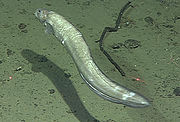
PERISCOP
Encyclopedia
The PERISCOP is a pressurized recovery device designed for retrieving deep-sea marine life at depths exceeding 2,000 metres. The device was designed by Bruce Shillito and Gerard Hamel at the Universite Pierre et Marie Curie. The name is an acronym for the French phrase Projet d’Enceinte de Remontée Isobare Servant la Capture d’Organismes Profonds ("Enclosure project for isobaric ascent serving to capture deep organisms").
 The PERISCOP differs from previous pressurized recovery devices in that it contains separate chambers – one for capture, one for recovery under exterior pressure, and one for transfer to the laboratory while maintaining pressure. Previous recovery devices used one chamber for all purposes. An arm designed to capture samples by force of suction is attached to the device. During ascent, pressure is maintained within the chamber by use of pressurized water. Pressurized gas was used in previous recovery devices, but it is not as safe as water. Temperatures below 2,000m usually range from 2-4 °C, and the device does not have a in-built cooling system. As a result, samples might experience heat shock
The PERISCOP differs from previous pressurized recovery devices in that it contains separate chambers – one for capture, one for recovery under exterior pressure, and one for transfer to the laboratory while maintaining pressure. Previous recovery devices used one chamber for all purposes. An arm designed to capture samples by force of suction is attached to the device. During ascent, pressure is maintained within the chamber by use of pressurized water. Pressurized gas was used in previous recovery devices, but it is not as safe as water. Temperatures below 2,000m usually range from 2-4 °C, and the device does not have a in-built cooling system. As a result, samples might experience heat shock
until they are returned to their usual temperature by surface equipment. Upon surfacing, samples can be observed, filmed, and/or photographed through transparent view ports in the device. Due to fluctuations in atmospheric pressure and temperature, the pressure in the device is not maintained perfectly. Recorded pressures during ascent and at the surface ranged from 74%-111% of the natural pressure.
 The device set a new record for the deepest live-fish capture under pressure by capturing a live Pachycara
The device set a new record for the deepest live-fish capture under pressure by capturing a live Pachycara
at 2,300 m. The previous record was 1,400 m. The capture was also the first to be performed at a hydrothermal vent
. The fish was reported to be alive and very active when observed on the surface. The device has also recovered several shrimp species (Mirocaris fortunata
, Chorocaris chacei
, and Rimicaris exoculata
) at vent fields Lucky Strike and Rainbow. Subsequent unpressurized captures of the same species resulted in stupefaction followed by death, indicating the necessity for such a device. The experiments were performed from the Pourquoi Pas? during an IFREMER
expedition. Future experiments are planned to study the Pompeii worm, one of the most heat-tolerant animals on earth.
Technology

Heat shock
In biochemistry, heat shock is the effect of subjecting a cell to a higher temperature than that of the ideal body temperature of the organism from which the cell line was derived.-Heat shock response:...
until they are returned to their usual temperature by surface equipment. Upon surfacing, samples can be observed, filmed, and/or photographed through transparent view ports in the device. Due to fluctuations in atmospheric pressure and temperature, the pressure in the device is not maintained perfectly. Recorded pressures during ascent and at the surface ranged from 74%-111% of the natural pressure.
Experiments

Pachycara
Pachycara is a genus of eelpouts containing at least 23 species.-References:* *...
at 2,300 m. The previous record was 1,400 m. The capture was also the first to be performed at a hydrothermal vent
Hydrothermal vent
A hydrothermal vent is a fissure in a planet's surface from which geothermally heated water issues. Hydrothermal vents are commonly found near volcanically active places, areas where tectonic plates are moving apart, ocean basins, and hotspots. Hydrothermal vents exist because the earth is both...
. The fish was reported to be alive and very active when observed on the surface. The device has also recovered several shrimp species (Mirocaris fortunata
Mirocaris
Mirocaris is a genus of shrimp associated with hydrothermal vents. Sometimes considered the only genus of the family Mirocarididae, Mirocaris is usually placed in the family Alvinocarididae. The genus contains two species, M. fortunata and M. indica; the former species M. keldyshi is now considered...
, Chorocaris chacei
Alvinocarididae
Alvinocarididae is a family of shrimp, originally described by M. L. Christoffersen in 1986 from samples collected by DSV Alvin, from which they derive their name. Shrimp of the family Alvinocarididae generally inhabit deep sea hydrothermal vent regions, and hydrocarbon cold seep environments....
, and Rimicaris exoculata
Alvinocarididae
Alvinocarididae is a family of shrimp, originally described by M. L. Christoffersen in 1986 from samples collected by DSV Alvin, from which they derive their name. Shrimp of the family Alvinocarididae generally inhabit deep sea hydrothermal vent regions, and hydrocarbon cold seep environments....
) at vent fields Lucky Strike and Rainbow. Subsequent unpressurized captures of the same species resulted in stupefaction followed by death, indicating the necessity for such a device. The experiments were performed from the Pourquoi Pas? during an IFREMER
Ifremer
Ifremer, standing for French Research Institute for Exploitation of the Sea is an oceanographic institution in France.- Scope of works :...
expedition. Future experiments are planned to study the Pompeii worm, one of the most heat-tolerant animals on earth.

